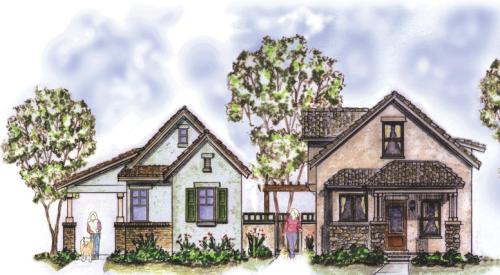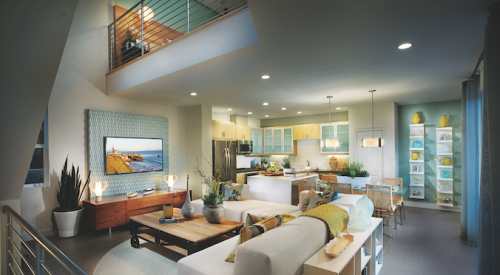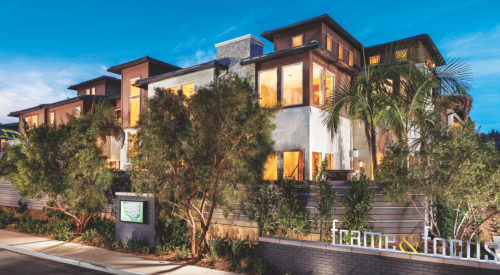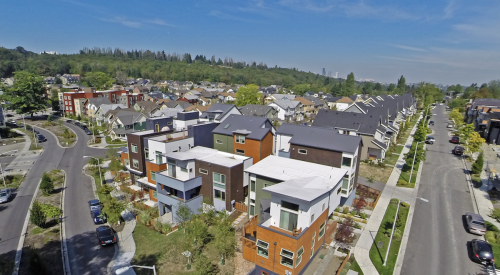 |
|
A potpourri of color and form: Colors — salmon red, forest green, earthy browns and charcoals — are reflective of their natural surroundings. The stick-framed community uses cast block, wood and a high-end synthetic stucco. Some front elevations face the internal courtyard; others the street. |
|
|
|
 |
|
Penthouse decks, two bedrooms, 3 and 1/2 baths, two-car garages, bonus office/bedrooms and decks are the norm. Buyers were given broad decorating leeway from countertops to cabinet styles, provided by a local cabinetmaker. The Hill residence (shown) eliminates a deck for a larger den and added an elevator, a sound system and other empty-nest upgrades. |
|
 |
|
 |
|
Living is compact, not cramped, "but if you do it well, people you'd never expect to like it will absolutely love it," says Volpe. The architect notes surprised reactions by buyers from "center-hall Colonial country" at the high ceilings, open floor plans, glass expanses and roof terraces that provide outdoor living even in mid-row homes. (Plans and interior photos are of the Hill residence.) See the floor plan |
|
Urban redevelopment provides numerous opportunities to builders, particularly smaller ones, for whom a small lot can present a world of opportunity. Villa Carabelli Townhomes in Cleveland, for example, turned an underutilized 1.4-acre parking lot into 20 upscale, four-story townhouses.
This was a unique lot and a unique development, because Alta House, a pillar of Cleveland's Little Italy neighborhood for more than a century, owns the land. The nonprofit organization partners with the United Way and other charitable organizations to provide youth, adult and seniors programs ranging from sports and recreation to health and counseling — bocce to boxing; flu shots and meals on wheels.
When recent years brought shortages in government and charitable grants, this small, high-density development filled the funding gap in a manner that earned it national recognition as a best in region winner in BALA.
OPPORTUNITIES:
"Our goal was to create an endowment to fund Alta House with the proceeds from the home sales," says Jim Teresi, president of Alta's board of trustees. This project would give Teresi and all parties involved a chance to save a piece of living history.
Research and planning took roughly two years. The board tapped Paul Volpe, managing principal of City Architects of Cleveland, for research, and eventually, land planning and architectural design. After plenty of deliberation and planning, the newly formed Alta Development LLC was formed with Teresi serving as construction manager. Jim Teresi and brother Anthony are third-generation builders.
The team selected Marous Brothers Construction of Willoughby, Ohio, as the general contractor. That company, a home builder unique in its ownership of most of the building trades it uses, had worked with Volpe before and had a track record of successful multifamily residential projects. The business model helps the company better control quality and diversify its business opportunities, since it is a developer and builder on other jobs, reports Scott Marous, chief operating officer. From the developer's perspective, Marous' direct employment of its trades was "essential" to winning the bid, says Teresi.
Alta committed early to building upscale townhouses because, Volpe explains, "the board wanted to bring back people who made their money and moved out of the neighborhood." He agreed this was a good marketing opportunity.
OBSTACLES:
There were some opponents to the project because Cleveland's Little Italy has a charm all its own, and roughly 7,000 residents, which Volpe says is proportionately larger than "Little Italies" elsewhere. Many third- and fourth-generation owners still have a stake in the neighborhood, but it's often as an absentee landlord. Proponents of the new townhomes successfully argued that Villa Carabelli would attract affluent residents who would be in the neighborhood full-time, enhancing everything from property values to the local restaurant, gallery and business environment.
Late in the process, the first-time developer learned that the tiny 1.4-acre parcel straddled Cleveland and the first-ring suburb of Cleveland Heights, which holds claim to 14 of the 20 lots. "There were discussions on annexation," says Volpe, "but cities don't easily give up their geography, and both cities wanted this housing. It will generate considerable revenue."
The project would have to proceed with twin tracks of planning board approvals. On the bright side, Cleveland deferred to Cleveland Heights to handle unified job-site inspections. And when Cleveland provided a 15-year, 100 percent tax abatement, which is a common perk, Cleveland Heights answered with a seven-year, 65 percent abatement for buyers. This was a generous gesture for the suburb because it is bristling with redevelopment projects and isn't as liberal in providing incentives. Alta House's good work beyond city limits figured into the decision.
"Construction-wise, the weather and the tight site made this a very tough project for us," says Scott Marous. The site was built into the side of a hill and gave no extra space away with its near-zero lot lines, so vehicle access and material storage space were limited. It wasn't the cold, but the unpredictability that hampered project management, because "every week we were dealing with some type of different condition," Marous explains. This slowed construction by about a third versus the typical 20 or 25 percent, but the COO credits superintendent Kevin Hawke for a "phenomenal job" managing a rotation system that kept trades whistling through the winter. "If you can keep people in rotation, ultimately your trades are going to make more money and promote harmony on the job site," says Marous.
OUTCOME:
Ten units were pre-sold starting in January 2003 and during model build-out. By early December 2004, four units remained. Increasing value, the developer is confident, covers selling price increases of $60,000 for some units.
Sales are fee-simple; buyers own the plot, not just the construction. Despite its luxury, the monthly homeowners' association fee is only $100. That and the tax abatement on remaining units are strong selling points. Hard construction costs were $112.33 per square foot. Proceeds, unreported, are now feeding an endowment and, in turn, Alta House's general fund.
This and a handful of recent new-construction projects in Little Italy, Volpe says, have "planted a seed. People are beginning to understand what we're doing, and with each project, they see their property values going up.
"Today I can tell you that the people who opposed Villa Carabelli are thrilled this project is in their neighborhood, " says Teresi. The project has "opened a lot of eyes," says Marous, noting a general rebirth of renovation in the neighborhood. "People are thinking, 'If Alta House is doing this, maybe we should do something.'"












